Lethwei
Lethwei (Burmese: လက်ဝှေ့; IPA: [lɛʔ.ʍḛ]),[1] or Burmese boxing, is a full contact combat sport from Myanmar that uses stand-up striking along with various clinching techniques.[2] Lethwei is considered to be one of the most brutal martial arts in the world,[3] as the sport is done bareknuckle with only tape and gauze while fighters are allowed to strike with their fists, elbows, knees, feet and headbutts are also permitted.[4][5][6]
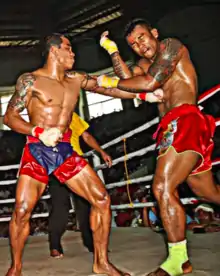 | |
| Also known as | Burmese boxing Burmese bareknuckle boxing The Art of 9 Limbs |
|---|---|
| Focus | Striking |
| Hardness | Full-contact |
| Country of origin | Myanmar |
| Famous practitioners | Kyar Ba Nyein, Dave Leduc, Too Too, Tun Tun Min, Saw Nga Man, Lone Chaw, Shwe Sai, Nilar Win, Soe Lin Oo, Cyrus Washington, Win Tun, Tway Ma Shaung, Shwe War Tun, Wan Chai |
| Highest governing body | Myanmar Traditional Lethwei Federation |
|---|---|
| First played | Pyu Empire c. 2nd century BCE - c. mid-11th century |
| Characteristics | |
| Contact | Full contact |
| Type | Martial art |
| Presence | |
| Country or region | Worldwide |
Disallowed in most combat sports, headbutts are important weapons in a Lethwei fighter's arsenal.[7] This is the reason Lethwei is also known as The Art of 9 Limbs,[8][9] and deemed one of the bloodiest martial art of the Indian cultural sphere.[3][10][11][12]
History
_(14802472843).jpg.webp)
Records exists of Lethwei matches dating back to the Pyu Empire in Myanmar. Lethwei, along with Bando and its armed sibling Banshay were successfully used by ancient Myanmar armies in many wars against neighboring countries.[13]
In ancient times, matches were held for entertainment and were popular with every strata of society. Participation was opened to any male, whether king or commoner. At that time, matches took place in sandpits instead of rings.[14] Boxers fought without protective equipment, only wrapping their hands in hemp or gauze. There were no draws, the fight went on until one of the participants was knocked out or could no longer continue. Back then, Burmese boxing champions would enter the ring and call for open challenges.[15]
Traditional matches include Flagship Tournament, which are still fought throughout Myanmar, especially during holidays or celebration festivals like Thingy an.[16][17]
Lethwei is related to martial styles such Muay Thai from Thailand, Pradal Serey from Cambodia, Muay Lao from Laos, Tomoi from Malaysia and Musti-yuddha from India.[18][19][20]
Establishing rules and regulations
Kyar Ba Nyein, who participated in boxing at the 1952 Summer Olympics, pioneered modern Lethwei by setting in place modern rules and regulations.[21] He travelled around Myanmar, especially the Mon and Karen states, where Lethwei is more actively practiced. After training with some of the fighters, Kyar Ba Nyein brought some to Mandalay and Yangon to compete in matches.[22]
The Myanmar Traditional Boxing Federation or MTBF is a branch of the Myanmar's Ministry of Health and Sports and is the highest governing body for Lethwei worldwide.[23][24]
In 1996, for the occasion of the Golden Belt Championship in Yangon, the MTBF implemented the modern Lethwei rules.[25] The bouts, along with the undercard fights, were organised by the Ministry of Sport, Myanmar Traditional Boxing Federation and KSM group. This marked a big addition to the art of Lethwei and potentially would make Burmese boxing more marketable internationally.[26]
In 2016, Myanmar's first international promotion called World Lethwei Championship or WLC launched its events using the modern Lethwei rules.[27][28]
In 2019, the WLC marked history by broadcasting the first Lethwei event internationally. WLC 7: Mighty Warriors was transmitted live on UFC Fight Pass.[29]
Attracting foreign fighters
From 7 to 12 July 2001, twelve years after Burma changed its name to Myanmar, the first international event took place in Yangon with professional fighters from the United States facing Burmese fighters under full traditional Lethwei rules. The delegation of three American fighters brought by the IKF were Shannon Ritch, Albert Ramirez and Doug Evans. Ritch faced Ei Htee Kaw, Ramirez faced Saw Thei Myo, and Evans faced openweight Lethwei champion Wan Chai. All three Americans lost to the Burmese. A revenge match with American and European fighters was cancelled the last minute by Lethwei promoters and the military in 2003.
From 10 to 11 July 2004, the second event headlining foreigners took place with four Japanese fighters fighting against Burmese fighters. They were mixed martial arts fighters Akitoshi Tamura, Yoshitaro Niimi, Takeharu Yamamoto and Naruji Wakasugi. Tamura knocked out Aya Bo Sein in the second round and became the first foreigner to beat a Myanmar Lethwei practitioner in an official match. International matches continued with the exciting Cyrus Washington vs. Tun Tun Min trilogy.
In 2016, after having previously fought to an explosive draw, Dave Leduc and Tun Tun Min rematched at the Air KBZ Aung Lan Championship in Yangon, Myanmar. The rematch was sweetened by an added bonus: ownership of the Lethwei Openweight World Championship Belt.[30] Leduc became the first non-Burmese fighter to win the Lethwei Golden Belt and become Lethwei world champion after defeating Tun Tun Min in the second round.[31][32]
Following his win, Leduc said in an interview, ″I have so much vision for this sport. I see Lethwei doing the same for Myanmar as what Muay Thai has done for Thailand."[33]
On April 18, 2017, for his second title defense under traditional rules,[34] Dave Leduc faced Turkish Australian challenger Adem Yilmaz at Lethwei in Japan 3: Grit in Tokyo, Japan.[35][33] This marked the first Lethwei World title fight headlining two non-Burmese in the sport's history and for the occasion, the Ambassador of Myanmar to Japan was present at the event held in the Korakuen Hall.[36]
In popular culture
The Lethwei has been featured in media, including films, television, manga, anime. The combat sport gained worldwide attention after Dave Leduc defeated Tun Tun Min in 2016.[37][38][39][40]
Film
| Movie | Year | Description |
|---|---|---|
| Born Warriors | 2016 | Trilogy documentary film about the art of Lethwei. |
| La Fosse aux Tigres | 2017 | Canal D documentary about the Dave Leduc vs Tun Tun Min II fight in 2016. La Fosse aux Tigres at IMDb |
| Into Dave's Fist | 2018 | Canal+ Myanmar documentary following Dave Leduc on his preparation for Dave Leduc vs Tun Tun Min III. |
| Still/Life | 2019 | A short Film about Lethwei in Myanmar by MultiVerse Advertising. |
| Myanmar Lethwei and Me | 2019 | Canal+ Myanmar documentary following Dave Leduc around Myanmar exploring the Lethwei culture. |
| Power & Martial Arts : Lethwei | 2019 | Short film about Lethwei following Dave Leduc around Yangon, Myanmar. Power & Martial Arts at IMDb |
| Underground | 2019 | Myanmar movie in Burmese language with Dave Leduc playing a gangster and using Lethwei in fight scenes. |
Television
Lethwei has been featured in television and documentaries.
| Television | Episode | Description |
|---|---|---|
| FightWorld | Myanmar: Crossroads | American docu-series on Netflix with Season 1 Episode 3 on Lethwei. FightWorld at IMDb[41] |
| Spirit of Fight | Season 1 & 2 | Canal+ Myanmar TV Series about Lethwei fighters on Canal+ Zat Lenn channel. |
| Le Canal Nouvelles | LCN: Denis Lévesque | Denis Lévesque and Dave Leduc discuss Lethwei. Denis Lévesque at IMDb[42] |
| The Joe Rogan Experience | MMA Show Episode #81 | Joe Rogan and Dave Leduc discuss Lethwei. JRE MMA Show #81 at IMDb[43] |
| World Lethwei Championship | WLC 7: Mighty Warriors | The first Lethwei event to be transmitted live on UFC Fight Pass.[44] |
Manga and Animation
Lethwei has been featured in the popular Japanese manga series Kengan Ashura. In the series, the Burmese Lethwei master named Saw Paing, is so indestructible that an opponent shatters every bone in their hand trying to punch him.[45]
| Manga or Animation | Character(s) |
|---|---|
| Kengan Ashura | Saw Paing (Burmese fighter) Kengan Ashura at IMDb |
Traditional gesture
Lekkha moun
The lekkha moun is the traditional gesture performed by Lethwei fighters to challenge their opponents with courage and respect. The lekkha moun is done by clapping 3 times with right palm to the triangle shaped hole formed while bending the left arm. The clapping hand must be in form of a cup, while the left hand must be placed under the right armpit. The lekkha moun is done at the beginning of the lethwei yay and can also be done while fighting.
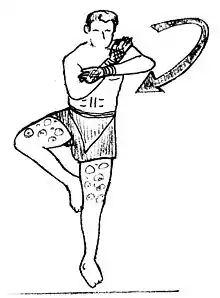
This invitation to fight is inspired from the birds of prey, like the eagle, as they flap their wings when flying and hunting.
Lethwei yay
The Lethwei yay could be described as a fight dance. It is performed before the fight as a way to showcase the fighter's skills and as a victory dance after the fight. The lekkha moun is usually confused with the lethwei yay, but the lekkha moun is done along with the Lethwei yay.
Rules
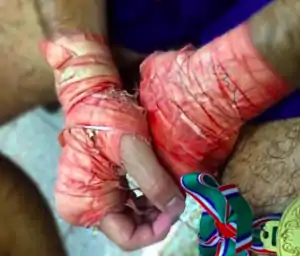
Permitted techniques
- Headbutts
- All punches
- All elbow strikes
- All knee strikes
- All kicks
- Extensive clinching
- Sweeps, throws and takedowns
The use of the feet, hands, knees, elbows and head is permitted.
Rounds
Each bout can be booked as a 3, 4 or 5 round fight with 3 minutes per round and a 2-minute break in between rounds. Championship bouts are 5 round fights with 3 minutes per round and a 2-minute break between rounds.
Fighting attire
The Burmese bareknuckle boxing rules prohibits the use of gloves.
- The fighters must only wear tape, gauze and electrical tape on their hands and feet.
- The fighters shall wear only shorts, without a shirt or shoes.
- The fighters must wear a groin protector.
- The fighters must wear a gum shield.
The fighters are required to apply the wrapping in front of the fight officials, who will endorse the wraps.
Referee
One referee oversees the fight. The referee has the power to:
- End the fight if he considers one fighter to be significantly outclassed by his opponent.
- Stop the fight and refer to the doctor if a fighter is heavily wounded.
- Warn the fighters. He makes sure the fight proceeds fairly and in compliance with the rules.
Traditional rules
The traditional rules, also known as yoe yar rules, come from the Burmese Myanma yoe yar Latway, which means Myanmar traditional boxing.[46] Traditional matches are still fought throughout Myanmar, especially during festivals or celebrations like Thingyan.[16] Traditional Lethwei is notorious for not having a scoring system and for its controversial rule of knockout only to win.
At the end of the match, in the eventually that there is no knockout or stoppage, if the two fighters are still standing, even if one fighter dominated the fight, the match is declared a draw. Fighters can win by incapacitating their rivals in a few different ways.
- The knockout (KO) is when the opponent falls on the floors, leans unconscious or if the fighter is unable to stand up or defend himself within 20 seconds (10 counts with 1 count every 2 seconds).
- When 3 counts are performed in a single round, the fight is terminated and scored as knockout (count limit)(KO).
- When 4 counts are performed during the entire duration of the fight, the match is terminated and scored as knockout (count limit)(KO).
- The technical knockout (TKO) is when the fighter forfeits, has an injury or is in a position that can damage or severely harm him if the fight continues. The ring doctor is consulted and is the one making that decision.[47]
Promotions that use traditional rules
- Most Lethwei promotions in Myanmar
- Annual Myanmar Lethwei World Championship
- Air KBZ Aung Lan Championship
- International Lethwei Federation Japan
- Challenge fights
- Flagship Tournaments
- Festivals & celebrations
Golden Belt
For Lethwei fighters, the traditional Golden Belt is regarded as the highest and most prestigious award.[48]
There is only one Golden Belt champion for each weight categories, with the Openweight class champion being considered the strongest fighter in Myanmar.[49] The Openweight Champion is the equivalent of being pound-for-pound champion in the world of lethwei.[50]
Win Zin Oo, Lethwei coach and gym owner explains:
If you win the golden belt you are the national champion, there is only one champion in each division, but there is also an openweight champion who is considered to be the best fighter in Myanmar.[20]
Injury time-out
- If a knockout or injury occurs, the fighter can take a special 2 minute time-out to recover. After the time-out the fighter can choose whether he wishes to continue the bout or not. Each fighter may only do so once during the fight and cannot be used in the fifth round.[51]
- The time-out can't be used in the fifth round.
- The use of the time-out is considered as 1 count.
Modern rules
In 1996, for the inaugural Golden Belt Championship, the two-minute injury timeout was removed and judges were added ringside. This modified ruleset helped prevented the outcome of a draw and helped choose a winner to advance in the tournament.[25] Former fighter Win Tun was the most successful fighter in Golden Belt Championship history, having won four Golden Belts. In recent years, the World Lethwei Championship, Myanmar's first international promotion, is the biggest proponent of the modern rules in order to follow the international safety and regulation for combat sports.[46]
Promotions that use tournament rules
- World Lethwei Championship
- Annual Golden Belt Championship
Judging
The knockout is still highly desired under this ruleset, but in the event that a bout goes the distance, judges will present a decision. The 3 judges score the bout based on aggression, number of significant strikes per round, damage and blood drawn. Fighters have a maximum of 3 knockdowns per round and 4 knockdowns in the entire fight before the fight is ruled a knockout.
Techniques
Aside from punches, kicks, elbows and knee attacks, Burmese fighters also make use of head-butts, raking knuckle strikes and take downs.
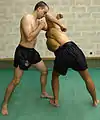 Spinning elbow strike
Spinning elbow strike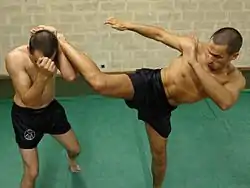 Roundhouse kick
Roundhouse kick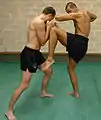 Knee and elbow strike
Knee and elbow strike Knee and punch
Knee and punch Jumping knee and elbow
Jumping knee and elbow Back hook kick
Back hook kick
Headbutt (Gowl Tite)
| English | Burmese | Romanization | IPA |
|---|---|---|---|
| Thrusting Head Butt/forward | ထိုးခေါင်းတိုက် | Htoe Gowl Tite | |
| Upward Head butt | ခေါင်းပင့်တိုက် | Gowl Pint Tite | |
| Side Head Butt | ခေါင်းရိုက် | Gowl yite | |
| Head Butt from the clinch | ချုပ်ခေါင်းရိုက် | Choke Gowl Yite | |
| Flying Head Butt/diving | ခုန်ခေါင်းတိုက် | Khnoe Gowl Tite | |
| Shooting / Rushing Head Butt | ခေါင်းဆောင့်တိုက် | Gowl Sount Tite | |
| Downward Head Butt | ခေါင်းစိုက်တိုက် | Gowl Site Tite |
Punching (Let Thee)
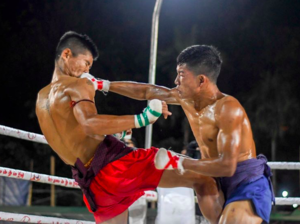
| English | Burmese | Romanization | IPA |
|---|---|---|---|
| Jab | ထောက်လက်သီး | Htouk Let Thee | |
| Cross (boxing)/Straight | ဖြောင့်လက်သီး | Fyount Let Thee | |
| Uppercut | ပင့်လက်သီး | Pint Let Thee | |
| Hook (boxing)/Swing | ဝိုက်လက်သီး | Wide Let Thee | |
| Overhand (boxing) | စိုက်လက်သီး | Site Let Thee | |
| Backfist | တွက်လက်သီး | Twet Let Thee | |
| Spinning Backfist | လက်ပြန်ရိုက် | Let Pyan Yite | |
| Hammer fist | ပင့်လက်သီး | Pint Let Thee | |
| Superman punch | လက်သီးပျံ / ခုန်ထိုး လက်သီး | Let Thee Pyan / Khone Htoe Let Thee |
Elbow (Tel Daung)
The elbow can be used in several ways as a striking weapon: horizontal, diagonal-upwards, diagonal-downwards, uppercut, downward, backward-spinning and flying. They can be used as either a finishing move or as a way to cut the opponent's eyebrow to draw blood.
| English | Burmese | Romanization | IPA |
|---|---|---|---|
| Horizontal Elbow | ဝိုက်တံတောင် | Wide Tel Daung | |
| Upward Elbow | ပင့်တံတောင် | Pint Tel Daung | |
| Downward Elbow | ထောင်းတံတောင် | Htoung Tel Daung | |
| Jumping Downward Elbow | တံတောင် ခုန်ထောင်း | Tel Daung Khone Htoung | |
| Elbow Thrust | ထိုးတံတောင် | Htoe Tel Daung | |
| Reverse Horizontal Elbow | တွက်တံတောင် | Twet Tel Daung | |
| Flying Elbow | တံတောင်ပျံ | Tel Daung Pyan | |
| Spinning Elbow | ပတ်တံတောင် / ခါးလှည့်တံတောင် | Pat Tel Daung / Khar Hlet Tel Daung |
Elbows can be used to great effect as blocks or defenses against, for example, spring knees, side body knees, body kicks or punches. When well connected, an elbow strike can cause serious damage to the opponent, including cuts or even a knockout.
Kicking (Kan)
| English | Burmese | Romanization | IPA |
|---|---|---|---|
| Roundhouse Kick | ခြေဝိုက်ကန် / ဝိုက်ခတ် | Chay Wide Kan / Wide Khat | |
| Spinning back Kick | နောက်ပေါက်ကန် | Nout Pouk Kan | |
| Outside low kick | အပြင်ခတ် | Al Pyin Khat | |
| Inside low kick | အတွင်းခတ် | Al Twin Khat | |
| Hook kick | ချိတ်ကန် | Chate Kan | |
| Side kick | ခြေစောင်းကန် | Chay zoung Kan | |
| Axe Kick | ခုတ်ကန် / ပုဆိန်ပေါက်ကန် | Khote Kan / Pal Sain Pouk Kan | |
| Jump round Kick | ခုန်ဝိုက်ခတ် | Khone Wide Kan | |
| Step-Up Kick | ပေါင်နင်းကန် | Pound Nin Kan |
Knee (Doo)
| English | Burmese | Romanization | IPA |
|---|---|---|---|
| Straight Knee Strike | တဲ့ထိုးဒူး | Delt Htoe Doo | |
| Spear Knee | လှံစိုက်ဒူ | Hlan Site Doo | |
| Side Knee Strike | ဝိုက်ဒူး | Wide Doo | |
| Upward Knee | ပင့်ဒူး | Pint Doo | |
| Downward Knee | ခုတ်ဒူး | Khote Doo | |
| Knee Slap | ရိုက်ဒူး | Yite Doo | |
| Double Flying Knee / Elephant Tusks flying Knee | စုံဒူးပျံ / ဆင်စွယ်ဒူးပျံ | Sone Doo Pyan / Sin Swal Doo Pyan | |
| Jumping Knee | ခုန်ဒူး | Khone Doo | |
| Step-Up Knee Strike | ပေါင်နင်းဒူး | Pound Nin Doo |
Foot-thrust
The foot-thrust is one of the techniques in Lethwei. It is used as a defensive technique to control distance or block attacks and as a way to set up attack. Foot-thrusts should be thrown quickly but with enough force to knock an opponent off balance.
| English | Burmese | Romanization | IPA |
|---|---|---|---|
| Push Kick | နင်းခြေ / တားခြေ | Nin Chay / Tar Chay | |
| Toe Push Kick | ခြေဦးထိုးကန် | Chay Oo Htoe Kan | |
| Jumping Push Kick | ခုန်ဆောင့်ကန် | Khone Sount Kan |
Note - The Myanglish spelling and phonetics based spelling are two different things. The words used are phonetics based words which are more friendly and easy to pronounce for non-Myanmar speaking people. The phonetics wording is provided by Liger Paing from United Myanmar Bando Nation.
Weight classes
| Weight class name | Upper limit | Gender | ||
|---|---|---|---|---|
| in pounds (lb) | in kilograms (kg) | in stone (st) | ||
| Light flyweight | 105 | 48 | 7.6 | Female |
| Flyweight | 112 | 51 | 8 | Male / female |
| Bantamweight | 119 | 54 | 8.5 | Male / female |
| Featherweight | 126 | 57 | 9 | Male / female |
| Lightweight | 132 | 60 | 9.5 | Male / female |
| Light welterweight | 140 | 63.5 | 10 | Male / female |
| Welterweight | 148 | 67 | 10.5 | Male |
| Light middleweight | 157 | 71 | 11.1 | Male |
| Middleweight | 165 | 75 | 11.8 | Male |
| Super middleweight | 174 | 79 | 12.4 | Male |
| Cruiserweight | 183 | 83 | 13 | Male |
References
- "Lethwei: Everything you need to know about Burmese bareknuckle boxing".
- Kyaw Zin Hlaing (1 September 2015). "Easy win for Lethwei fighters". Myanmar Times.
- Karl R. De Mesa (12 March 2019). "The Most Brutal Sport in the World Uses Bare Knuckles and Head Butts". VICE.
- "Lethwei: The world's most brutal sport". Ugly Chicken. 4 October 2017.
- Calderon, Justin (23 September 2014). "Punches, headbutts, knockouts: Asia's 'new' martial arts sensation". CNN.
- Olavarria, Pedro (2 December 2014). "Bando: The style of Burmese Martial Arts". Vice Fightland.
- Darren. "Lethwei Fighter Lands Torpedo Headbutt KO". Scrap Digest. Retrieved 17 July 2020.
- Zarni Pyo (21 July 2017). "The Art Of Nine Limbs". Myanmar Times.
- Steven Rae (13 March 2019). "Lethwei: Everything you need to know about Burmese bareknuckle boxing". The Body Lock.
- Paul Millar (18 July 2018). "BAREKNUCKLE BOXING Blood sport". South East Asia.
- Jack Board (27 October 2019). "From Myanmar, with blood: The Singaporean fighting tradition to take the martial art of lethwei to the world". Chennel News Asia.
- Matthew Scott (11 November 2017). "'Once you get a taste, there's no turning back': brutal, bloody lethwei making Myanmar a martial arts mecca". SCMP.
- "Lethwei : Myanmar bare knuckle boxing". Full Contact Martial Arts. Archived from the original on 12 February 2017.
- Giordano, Vincent. "Born Warriors: Fighting for Survival". 15 July 2015.
- Journal of the Royal Society of Arts, Volume 41. G. Bell and Sons. 1893. p. 151.
At a Burmese boxing match a champion will jump into the ring and dance about, smacking his breast and arms and cracking his fingers, challenging all comers.
- Giordano, Vincent. "Burmese Lethwei: The Tradition of Child Fighters". AllAboutMartialArts.
- "Women join in Myanmar's ferocious kickboxing". Bangkok Post. 1 April 2016.
- Wikipedia, Source (1 September 2013). "Combat Sports: Boxing, Taekwondo, Judo, Fencing, Sumo, Kendo, Grappling, Kickboxing, Savate, Boxing Training, Paralympic Judo, Brazilian Jiu-Jitsu, Mi". General Books. Retrieved 5 April 2018 – via Google Books.
- Andre Malerba (22 September 2013). "Traditional kickboxing, an ancient sport makes a revival". Myanmar Times.
- Goyder, James (22 July 2015). "Inside a Burmese Lethwei Gym". VICE Fightland.
- "Kyar ba nyein". Scribd. Retrieved 4 March 2015.
- Giordano, Vincent (15 July 2015). "Born Warriors Redux: A New Era Begins for an Ancient Sport".
- "Tun Tun Min wins Myanmar Lethwei World Championship". Myanmar Daily News. 19 August 2019.
- Goyder, James (17 December 2014). "The Burmese Kickboxing Style of Lethwei Expands Into Singapore". Vice Fightland.
- Kyaw Zin Hlaing (20 May 2013). "Two Two wins Golden Belt Championship". Myanmar Times.
- Giordano, Vincent (13 August 2015). "Burmese Lethwei: Bare Knuckle Revival". Archived from the original on 6 September 2015.
- "World Lethwei Championship: Biggest Int'l. Lethwei Competition in Myanmar". myanmaritv.com. Retrieved 25 May 2017.
- "Zay Thiha: Brining Lethwei to the World". ROUGH Magazine. 11 August 2017.
- "World Lethwei Championship Lines Up Big Card for UFC Fight Pass Debut". The Fight Nation. 31 January 2019.
- "デーブ・レダックチャンピオン Dave Leduc Champion". The Weekly Fight Japan. 12 December 2016.
- Kyaw Zin Hlaing (13 December 2016). "Myanmar's lethwei goliath toppled by Canadian 'Dave'". Myanmar Times.
- Anthony Da Silva-Casimiro (20 December 2016). "Tout sauf de la chance pour Dave Leduc". La Revue. Archived from the original on 12 June 2018.
- Eaton, Matt (18 April 2017). "Embracing tradition: The rise of LethweiI". The Fight Nation.
- "Weigh ins for Lethwei in Japan 3 GRIT - 明日開催!第3回日本ラウェイ大会『ラウェイinジャパン 3 ~GRIT~』後楽園ホール大会!計量と公開記者会見終了". The Weekly Fight. 17 April 2017.
- "4・18『Lethwei in Japan 3 ~GRIT~』全対戦7カード発表!ミャンマーvs.日本(4対4)vs.USA(2対2)にカナダの現ラウェイ王者が再参戦!相手は第1回大会参戦のオーストラリア選手! – 週刊ファイト". The Weekly Fight. 3 March 2017.
- "Lethwei in Japan 3 GRIT" [Lethwei in Japan 3 GRIT is the third tournament is Japan]. Myanma Allin Daily (in Burmese). 21 April 2017.
- Eaton, Matt (15 May 2017). "Bare essentials: Canadian raises profile of Burmese combat sport". Asia Times.
- Matthew Carter (22 June 2010). "Dave Leduc On The Cover Of Legendary Martial Arts Magazine". Lethwei World.
- Karl D. De Mesa (12 March 2019). "Inside a Burmese Lethwei Gym". Vice.
- Rhodri Morgan (20 July 2019). "A royal portrait: Dave Leduc, King of Lethwei". The Body Lock.
- "Can Netflix's Fightworld help rehabilitate MMA's image?". The Guardian. Retrieved 11 July 2020.
- "Dave Leduc veut devenir ambassadeur de lethwei". TVA Nouvelles. 18 January 2019.
- Matt Eaton (29 October 2019). "Dave Leduc Says Lethwei Is Coming To USA". The Fight Nation. Archived from the original on 2 February 2020.
- "World Lethwei Championship Lines Up Big Card for UFC Fight Pass Debut". The Fight Nation. 31 January 2019. Archived from the original on 2 February 2020.
- Patrick L. Stumberg (27 April 2020). "Fighting Fiction: 'Kengan Ashura' perfects the martial arts tournament arc". MMA Mania.
- Mark Schroeder (17 September 2019). "Introduction to Lethwei". The Fight Site.
- Xegarra, Guillermo (7 June 2016). "Born Warriors: Documentarian Vincent Giordano Interview Part 2". Matial Arts Entertainment.
- Kyaw Zin Hlaing (13 December 2016). "Myanmar's lethwei goliath toppled by Canadian 'Dave'". Myanmar Times.
- Hlaing, Kyaw Zin (22 December 2015). "A Tun Tun Minute". Myanmar Times. Retrieved 30 November 2018.
- "SONS OF LETHWEI LEGENDS TO MEET IN THE RING AT WLC: KING OF NINE LIMBS". Asia Persuasian MMA. 22 June 2019.
- Looi, Florence (8 September 2015). "Myanmar's Lethwei fighters bare their knuckles". Al Jazeera.
Further reading
- Maung Gyi, Burmese bando boxing, Ed. R.Maxwell, Baltimore, 1978
- Zoran Rebac, Traditional Burmese boxing, Ed. Paladin Press, Boulder, 2003
| Wikimedia Commons has media related to Lethwei. |

